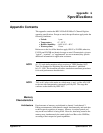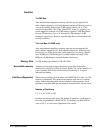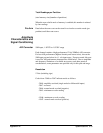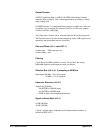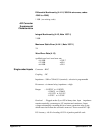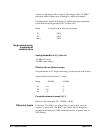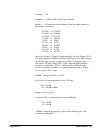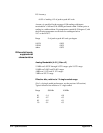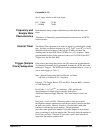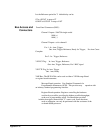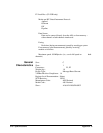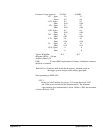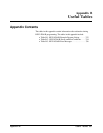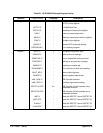
Crosstalk (4.11)
On 1V range, relative to full-scale input:
DC - 1 MHz -75 dB
1 - 10 MHz -70 dB
Frequency and
Sample Rate
Characteristics
Both channels always sample simultaneously at the indicated rates and
times.
Tolerances: All internally-generated frequencies and rates are ±0.0075%
initial tolerance.
Internal Timer The Internal Timer generates time intervals useful in controlling the sample
rate. It divides a reference frequency by 1x10
n
, 2x10
n
, or 4x10
n
, n = 0 to 8.
When the reference frequency is the internal 20 MHz oscillator, the
resulting rates are from 0.05 Sa/s to 20 MSa/s in a 1,2,5 sequence. Other
programmable choices for the reference source are VXI CLK10, the ECL
Trigger lines, and the Ext2 BNC.
Trigger (Sample
Clock) Subsystem
Each event in this subsystem causes one A/D conversion in both channels.
(In Standard Commands for Programmable Instruments (SCPI), this is the
meaning of "Trigger". The SCPI term for the commencement of a series of
one or more triggers is "Arm".)
Rate: (Internal Timer using built-in reference oscillator)
0.05 Sa/s to 20 MSa/s in 5,1,2 sequence
External: VXI Trigger Busses (TTL and ECL), External BNCs, software,
or VME Read cycle
Post-Count: 1, or 7 to 2
24-1
, or continuous. (This specifies the
desired number of sample triggers after the Arm event.)
Additional limitations apply when the "Pre-Count"feature is used; see
below.
Pre-Count: 0, or 3 to 65535. When this mode is used (pre-count0)
the Digitizer samples continuously until the pre-count is satisfied and then
an Arm event occurs. Memory is used as a circular buffer with older
readings overwritten by newer readings. The programmed
pre-count value specifies the number of pre-arm samples to be protected
from overwriting by post-arm sample data. This mode limits the number of
Post-Count read-ings: The total of (pre-count + post-count) must be no
larger than the memory partition size.
Appendix A Specifications 325



